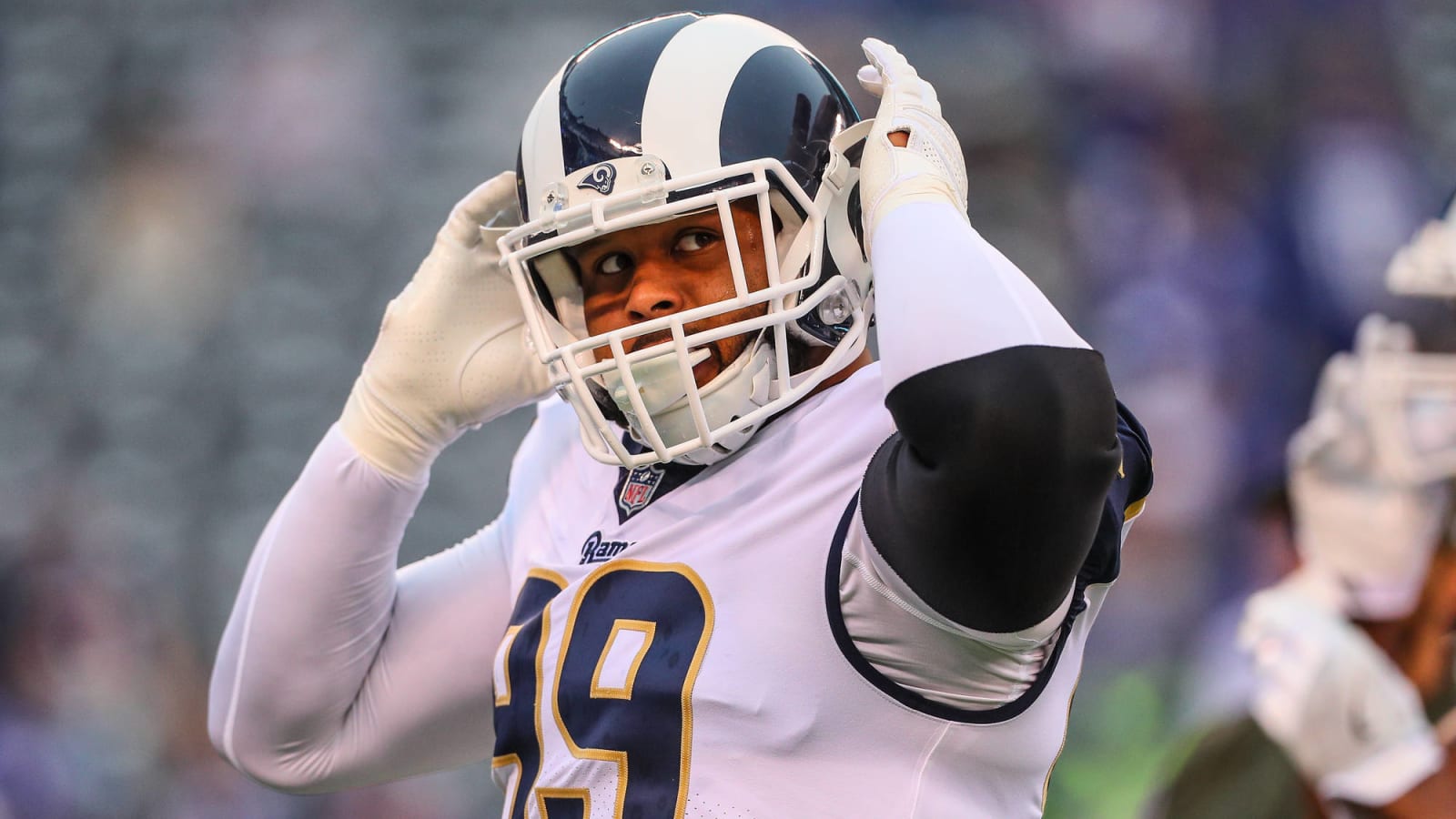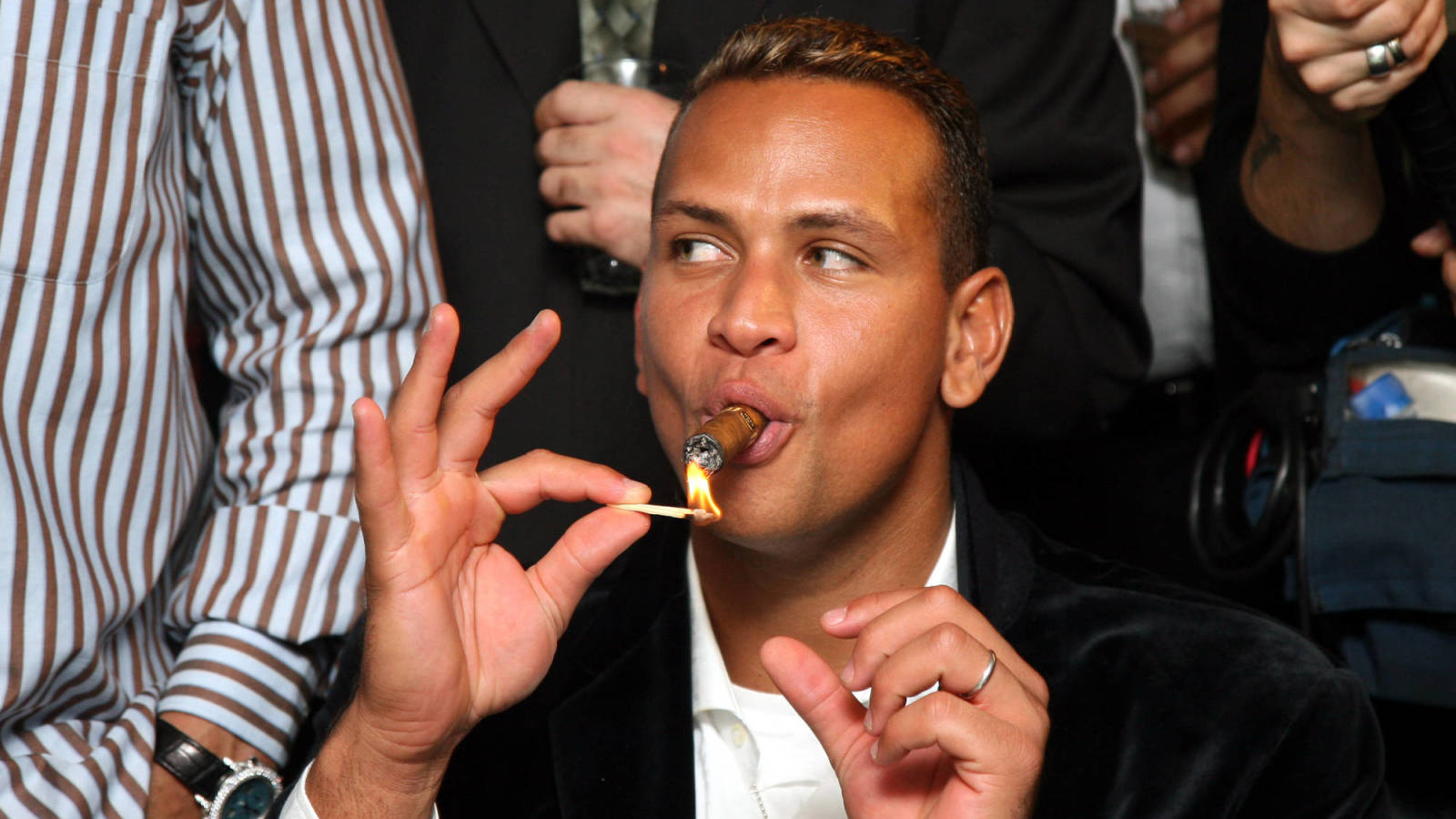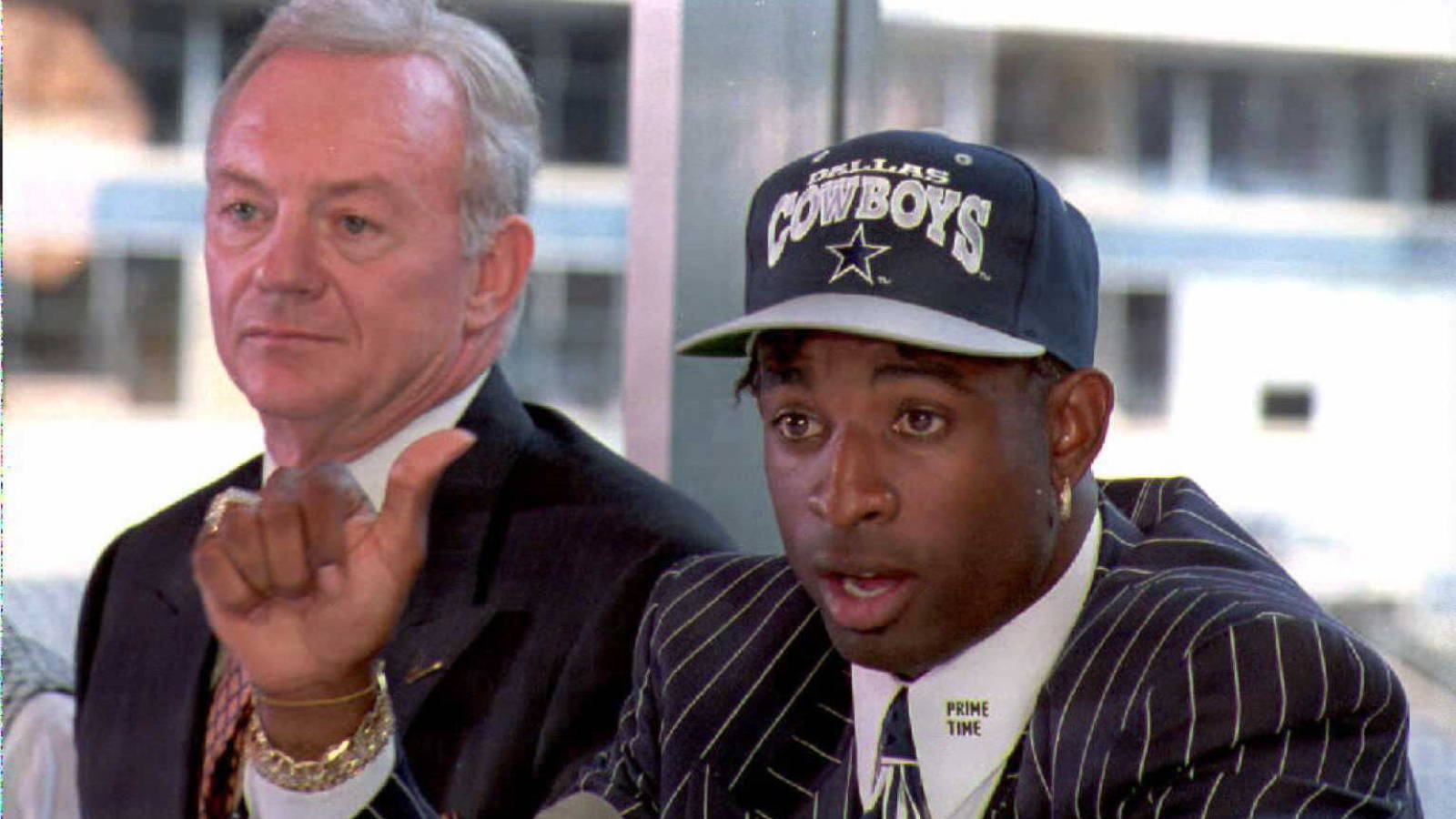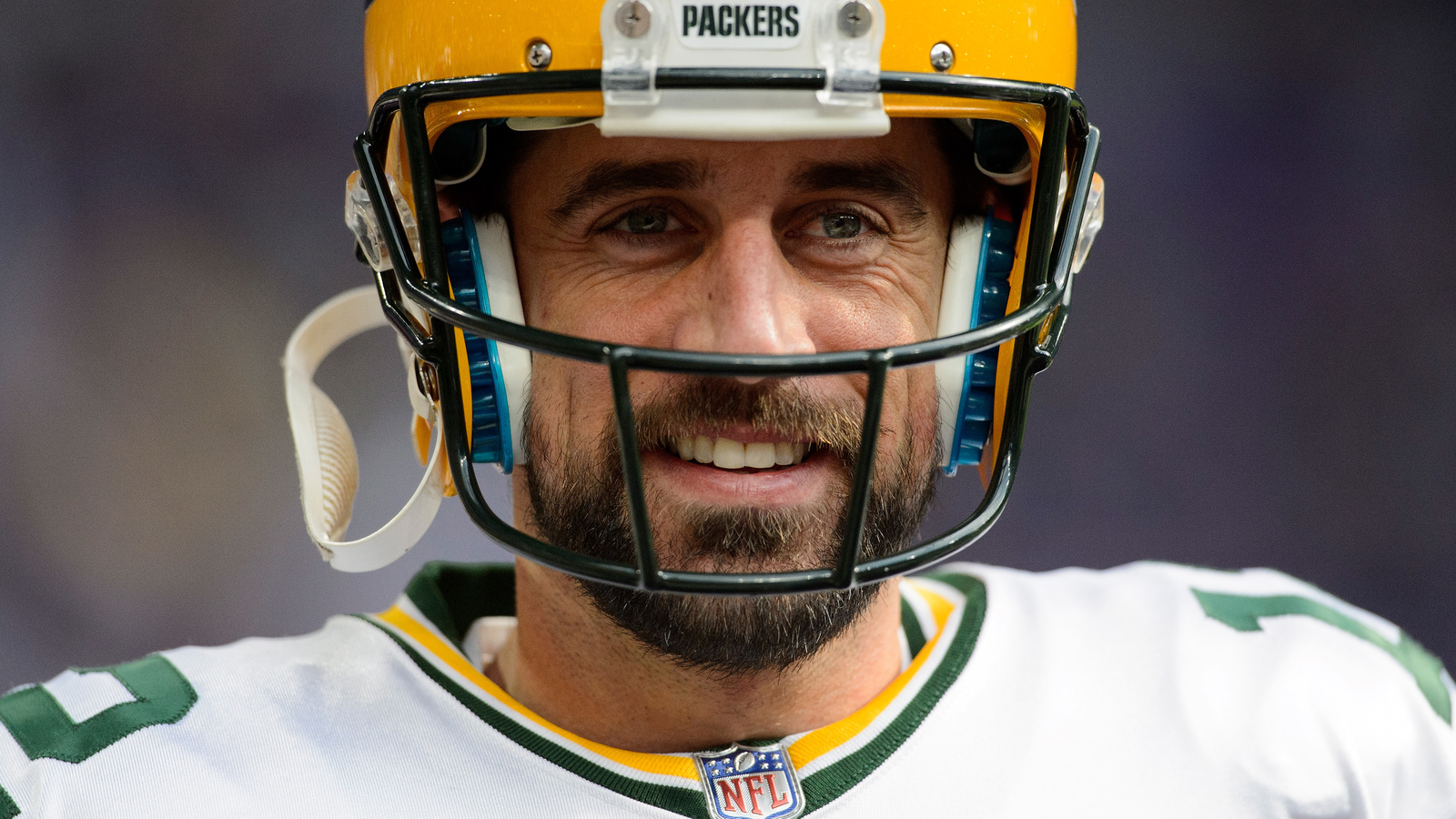
What would it look like if the NFL had no salary cap?
For the second year in a row, Aaron Donald skipped the Los Angeles Rams’ OTAs. He will skip minicamp and then training camp, and he may even forgo regular-season games if he doesn’t get a new contract. Donald isn’t alone either. A number of stars including Juilo Jones, Khalil Mack and Earl Thomas, among others, also plan to skip minicamp. Why is this happening?
The “why” is easy. From Donald’s perspective, he is the reigning NFL Defensive Player of the Year and most dominant force in the NFL. The statistical gap between him and the next best defensive lineman was absolutely staggering last season. Yet, Donald enters his fifth NFL season as the 225th highest-paid player in the NFL, 24th highest-paid defensive tackle and 11th highest-paid Rams player.
From the Rams’ perspective, because of the NFL’s franchise-friendly collective bargaining agreement (better step your game up next time, DeMaurice Smith!), they have the leverage in negotiations. Donald was on a four-year rookie deal with a fifth-year team option, which the Rams exercised. He’ll be a restricted free agent next offseason and can be franchise tagged for multiple seasons after that.
Herein lies the predicament: If the Rams use their leverage, it ruins their comradery with Donald and all but guarantees that he holds out or eventually leaves. On the other hand, if they do right by Donald and give him a long-term deal, it cripples the Rams’ salary cap and depth moving forward — meaning their Super Bowl window could close as quickly as it opened, especially considering they’ll have to break the bank for Todd Gurley and Jared Goff in the near future. Unless Donald is willing to take a Tom Brady-esque discount, this situation will loom over the franchise until one side gives in. It’s too bad it has to be this way…
Since we’re entering the dog days of the sports year, let’s ignore the fact that the NFL’s CBA doesn’t expire until the end of the 2020 season and do a fun NFL hypothetical: What if the NFL didn’t have a salary cap?

The NFL would mirror Major League Baseball, right?
Of the four major professional sports leagues in America, only Major League Baseball operates without a salary cap. Thus, the starting point in this exercise is assessing whether an uncapped NFL would mirror the current MLB landscape.
The big-picture similarities between the two are self-evident. On the ownership level, Jerry Jones would follow in the footsteps of his spirit animal George “The Boss” Steinbrenner and essentially try to spend his way to a Super Bowl every season. Jones’ Dallas Cowboys, along with other big-market teams like the New England Patriots and Washington Redskins, would have bidding wars for players that would resemble the Yankees and Red Sox in the late-1990s and early-2000s.
On the other end of the spectrum, small-market teams like the Green Bay Packers and Buffalo Bills would face serious dilemmas each time their top talent hit free agency. Would they choose to sell high on all of their assets and tank in order to make a push once their next wave of talent develops like the Florida Marlins did in 1997 and 2003? Twice they made a run, won the World Series, then gutted their roster and focused on developing prospects because they couldn’t afford to keep their All-Star players. Or would small-market teams choose to allocate much of their salaries to one or two star players and risk an Alex Rodriguez-Texas Rangers-type situation where they couldn’t fill the rest of their rosters with enough talent to compete?
Or would it?
While there are obvious parallels between the MLB and this theoretical NFL, the analogy is far from perfect. For one, there’s no minor league system for small-market teams to develop talent in the NFL. Would an uncapped league give way to a minor league? Could we still call it the SEC?
The MLB analogy gets further thrown into flux when you consider the revenue the NFL generates and how that impacts the concept of a “small market” team. Consider the following:
- In 2017, the NFL brought in an estimated $14 billion in total revenue whereas the MLB brought in $10 billion.
- Comparing the top- (Cowboys vs. Yankees) and bottom- (Oakland Raiders vs. Oakland A’s) grossing teams in the NFL and MLB yields similar discrepancies.
- In the NFL, the teams split $7.8 billion in revenue sharing while the MLB teams split approximately $1.56 billion.
- The lowest operating income in the NFL last year was the Raiders at $41 million; there were 22 MLB teams below that, including six with negative operating incomes.
Upon further review, the NFL probably makes too much money for there to be “small market” teams in the same sense as the MLB.

A better analogy
A better analogy for an uncapped NFL would probably be, well, the NFL. Before 1994, there was no salary cap. While the NFL wasn’t generating nearly the same revenue as it is today, the impact on league-wide parity would probably be similar. Instead of having nine different Super Bowl winners in the past 10 years, there’d be more dynasties like the 49ers and Cowboys of the '80s and '90s and Steelers of the '70s.
Teams with transcendent stars would have no excuse but to spend money to surround those players with depth and quality veterans as opposed to today, where teams have to strategically fill out their rosters with rookies and players making the NFL minimum. There’d be fewer instances of teams trying to trade star players near the end of their primes like Earl Thomas for a measly second-round draft pick. As a result, player values would increase, and draft pick values would decrease.
Although there would be less parity because teams like the Cowboys would be willing to spend more in free agency, other teams could remain competitive by offering early extensions to retain talent. With no cap, franchise tags would no longer exist or would, at least, become less impactful. Instead, a team like the Rams would likely have offered Donald a huge extension with lots of guaranteed money well before his rookie deal expired. Because of the game’s violent nature and frequency of career-shortening injuries, many players would likely take the guaranteed money that an extension would afford them rather than bet on themselves staying healthy until they were unrestricted free agents. There’d be less player movement in free agency with injury-prone positions like running back, offensive line and most defensive positions.
Quarterbacks (and to an extent, wide receivers), on the other hand, would be a different story. In an uncapped league, quarterbacks (and their agents) would hold an inordinate amount of power.

What would Aaron Rodgers make in an uncapped NFL?
The most fun part of this hypothetical is guessing what the players would make. Quarterbacks make the most money by a wide margin in today’s NFL, as the top 17 highest-paid players are quarterbacks. There’s little reason to doubt that that trend would change without a salary cap. Matt Ryan is currently the leader in the clubhouse, set to make $30 million this season. Rodgers is expected to be the next mammoth contract. Could he make $40 million in an uncapped NFL? Yes, easily. How about $50 million? That’s more like it.
The easiest approach to estimating Rodgers’ salary in an uncapped NFL is to compare other top-earning athletes’ salaries to their respective teams' yearly revenue. For instance, in his final season with the Chicago Bulls, Michael Jordan made $33 million — approximately 30 percent of the Bulls’ revenue that year. Not surprisingly, no athlete since has even approached that figure percentage-wise (and the NBA had a lockout the next season). So, the Jordan split is a bit too high. Instead, let’s use current splits.
In the NBA, Steph Curry made $34.6 million this season, a little under 10 percent of the Golden State Warriors’ revenue. In the MLB, Clayton Kershaw is making $35.5 million this season, which translates to 7 percent of the L.A. Dodgers’ revenue. In the NFL, Ryan’s $30 million is good for approximately 8 percent of the Atlanta Falcons’ revenue, but the Falcons only had the 23rd-highest revenue. When you consider Rodgers’ ability compared to Ryan’s and the Falcons’ revenue, the sweet spot, depending on the team, is probably between 8 percent to 13 percent of a team’s revenue.
Given the 8 percent to 13 percent parameters, a surprising number of teams could afford a $50 million quarterback. The median revenue for NFL teams last season was $392 million — thus, a $50 million quarterback would still be less than 13 percent of half the NFL teams’ revenues. If the Cowboys were making the offer, it’d be less than 6 percent of the team’s revenue.
In 2015, ESPN published an article suggesting that Russell Wilson could command a 10-year, $300 million deal if the NFL had no salary cap. The next year, after the Patriots’ Super Bowl victory, the Washington Post published an article where an agent was asked what Tom Brady would command in an uncapped league, “My God. Some of these owners would go crazy and pay these quarterbacks $40-45 million.” That was before it was reported that the NFL increased its revenue by 10 percent in the 2016-17 season. This article is being written before the NFL has reported the same for the 2017-18 season.
Therefore, in an uncapped league, an unrestricted Aaron Rodgers would probably start his bidding at five years, $250 million — and, if he could get Uncle Jerry involved in the bidding war, he could probably get most, if not all of that deal guaranteed.
More must-reads:
- The Steelers should swallow their pride and pay Le'Veon Bell
- NFL ready to reap rewards of legalized gambling whether it admits it or not
- The 'Active sack leaders for every NFL team' quiz
Breaking News
Customize Your Newsletter
 +
+
Get the latest news and rumors, customized to your favorite sports and teams. Emailed daily. Always free!

